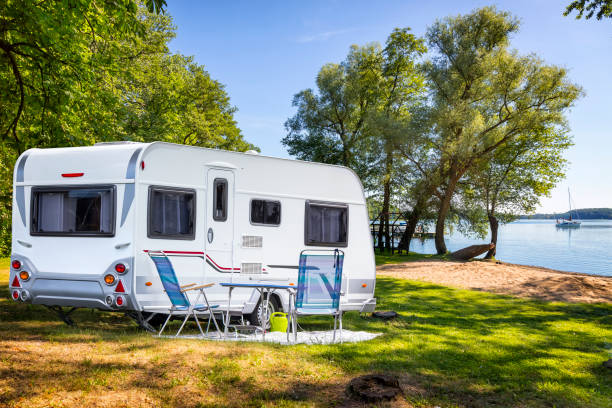When you’re thinking about putting an RV into a rental program—whether it’s your first unit or your tenth—the obvious question is:
“What kind of RV will rent the most and make me the most money?”
It’s a smart question. But too often, people answer it based on personal preference—or what’s sitting on the lot.
At RVM, we take a different approach. We look at real-world booking data across the country, track guest behavior, and talk to renters constantly. The result? A clear picture of what types of RVs consistently outperform in rental programs—and which ones can quietly kill your returns.
This blog breaks it down: the best RVs by class, floorplan, and features—and why they work so well in the real rental world.
Table of Contents
- Why Rental Performance Matters More Than MSRP
- The Sweet Spot: Class C Bunk Models
- Why Class B Vans Are Instagram Famous—but Hard to Scale
- The Dark Horse: Lightweight Travel Trailers
- What Doesn’t Rent Well (Even If It Looks Cool)
- Pet-Friendly, Kid-Friendly = Booked Solid
- Floorplans That Punch Above Their Weight
- Case Study: One Owner, Three RV Types—One Clear Winner
- How RVM Helps You Match Inventory to Market Demand
- Conclusion: Buy for Renters, Not for Yourself
1. Why Rental Performance Matters More Than MSRP

It’s easy to get attached to a specific rig. Maybe you love that new Super C or the luxury fifth wheel with massage chairs. But here’s the reality:
What you love isn’t always what the market wants.
If you’re using your RV personally 90% of the time, buy what makes you happy.
But if it’s going into a managed rental program?
Buy what books.
You don’t need the flashiest unit—you need the most rentable one. And that’s not always the most expensive rig on the lot.
2. The Sweet Spot: Class C Bunk Models
When it comes to rental ROI, nothing beats a well-designed Class C with bunks.
Why? Because:
- They sleep 6–8 people
- They’re easy to drive (no special license needed)
- They feel approachable to first-timers
- Families love them
One of our top-performing units across RVM’s network is a 31’ bunkhouse Class C. It’s booked 180+ nights per year in multiple regions. That’s hotel-level occupancy.
If you’re starting with just one unit, this is the most bankable choice.
3. Why Class B Vans Are Instagram Famous—but Hard to Scale
We get the appeal. Sleek, nimble, and all over social media—Class B vans are traveler eye candy.
But behind the scenes? The numbers don’t always add up.
Pros:
- High nightly rates
- Great for couples and solo travelers
- Stylish, fuel-efficient
Cons:
- Limited sleeping capacity (usually just 2)
- Harder to justify price for families
- Not as scalable in non-urban markets
They can be part of your fleet—but don’t expect them to carry your income alone.
4. The Dark Horse: Lightweight Travel Trailers
Towables get overlooked—but in the right setup, they can out-earn motorhomes.
Small travel trailers (under 25’) with easy towing weights (under 5,000 lbs) hit a sweet spot:
- Can be towed by midsize SUVs
- Ideal for regional/local travel
- Huge value for budget-minded renters
They’re also cheaper to buy and maintain, meaning lower break-even thresholds. Combine them with delivery, and you’ve got a sleeper hit.
5. What Doesn’t Rent Well (Even If It Looks Cool)

Here’s what we don’t recommend for your first rental unit:
- Luxury fifth wheels: Hard to tow, niche market, high damage risk
- Older rigs over 10 years old: Lower booking rates, more breakdowns
- Rare/quirky floorplans: Confuse renters, harder to photograph/market
You might love it—but if guests don’t understand it or can’t use it easily, it won’t rent well. Think like a renter, not like a collector.
6. Pet-Friendly, Kid-Friendly = Booked Solid
It’s not just about the RV itself—it’s about the experience it supports.
Units that are:
- Pet-friendly (with easy-to-clean flooring)
- Kid-friendly (with bunks, seatbelts, space to play)
- User-friendly (with simple instructions and checklists)
...almost always rent more frequently and get better reviews.
At RVM, we help hosts lean into these features—and it pays off in 5-star bookings.
7. Floorplans That Punch Above Their Weight
Some layouts just work better in rental settings. The ones we see guests love:
- Corner bunks or bunk slides (more sleeping room, same footprint)
- U-dinette and jackknife sofa combo (convertible seating/sleeping)
- Split bathroom with hallway access (less awkward at campgrounds)
- Outdoor kitchens or fridges (major bonus for families)
You don’t need every luxury—just smart design that makes travel easier.
8. Case Study: One Owner, Three RV Types—One Clear Winner
One of our hosts in Arizona started with a 2021 Class B van. It booked decently—about 85 nights that year.
Next, they added a lightweight bunkhouse trailer: better ROI, but more logistics.
Finally, they bought a used 2019 Class C with bunks.
In the next 12 months, that Class C:
- Booked 160 nights
- Earned more gross revenue than the other two units combined
- Had the highest guest satisfaction score
Sometimes the obvious choice really is the right one.
9. How RVM Helps You Match Inventory to Market Demand

At RVM, we don’t just list whatever unit you have. We help you buy, prepare, and price for real demand.
With us, you get:
- Rental performance data by region and rig type
- Purchase consultations before you buy
- Design and layout suggestions
- Predictive income modeling
- Ongoing optimization once your unit is live
Think of it like buying an income property with a property manager built in.
10. Conclusion: Buy for Renters, Not for Yourself
If you’re building an RV rental business—even as a side hustle—the key isn’t buying what you like.
It’s about understanding what guests love:
- Easy to use
- Comfortable to sleep in
- Simple to tow or drive
- Safe and clean
- Ready to go
At RVM, we help you find the right unit—not the most expensive one—so you can earn faster and scale smarter.
Buy smart. Rent often. Grow confidently.
— RVM Team

